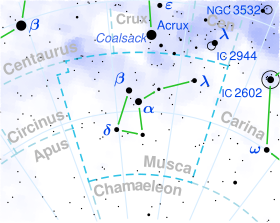| Observation data Epoch J2000 Equinox J2000 | |
|---|---|
| Constellation | Musca |
| Right ascension | 11h 51m 51.22590s[1] |
| Declination | −65° 12′ 21.2653″[1] |
| Apparent magnitude (V) | 4.89[2] |
| Characteristics | |
| Spectral type | B4V[3] |
| U−B color index | -0.53[4] |
| B−V color index | -0.11[4] |
| Astrometry | |
| Radial velocity (Rv) | +20.60[5] km/s |
| Proper motion (μ) | RA: -33.88[1] mas/yr Dec.: -5.13[1] mas/yr |
| Parallax (π) | 9.00 ± 0.47 mas[1] |
| Distance | 360 ± 20 ly (111 ± 6 pc) |
| Absolute magnitude (MV) | -0.33[2] |
| Details | |
| Mass | 5.0[6] M☉ |
| Luminosity | 251[2] L☉ |
| Temperature | 20,560[7] K |
| Metallicity [Fe/H] | 0.00[8] dex |
| Rotational velocity (v sin i) | 57[3] km/s |
| Other designations | |
| Database references | |
| SIMBAD | data |
HD 103079 is a class B4V[3] (blue main-sequence) star in the constellation Musca. Its apparent magnitude is 4.89[2] and it is approximately 362 light years away from Earth based on parallax.[1] It is a member of the Lower Centaurus–Crux subgroup of the Scorpius–Centaurus association, a group of predominantly hot blue-white stars that share a common origin and proper motion across the galaxy.[9]
It has one reported companion with a magnitude of 7.41 and separation 1.549".[10][11]
References
- ^ a b c d e f Van Leeuwen, F (2007). "Validation of the new Hipparcos reduction". Astronomy & Astrophysics. 474 (2): 653–664. arXiv:0708.1752. Bibcode:2007A&A...474..653V. doi:10.1051/0004-6361:20078357. S2CID 18759600. Vizier catalog entry
- ^ a b c d Anderson, E; Francis, Ch (2012). "XHIP: An extended hipparcos compilation". Astronomy Letters. 38 (5): 331. arXiv:1108.4971. Bibcode:2012AstL...38..331A. doi:10.1134/S1063773712050015. S2CID 119257644. Vizier catalog entry
- ^ a b c Hoffleit, D; Warren, W. H (1995). "VizieR Online Data Catalog: Bright Star Catalogue, 5th Revised Ed. (Hoffleit+, 1991)". VizieR On-line Data Catalog: V/50. Originally Published in: 1964BS....C......0H. 5050. Bibcode:1995yCat.5050....0H.
- ^ a b Mallama, A (2014). "Sloan Magnitudes for the Brightest Stars". The Journal of the American Association of Variable Star Observers. 42 (2): 443. Bibcode:2014JAVSO..42..443M.Vizier catalog entry
- ^ Evans, D. S (1967). "The Revision of the General Catalogue of Radial Velocities". Determination of Radial Velocities and Their Applications. 30: 57. Bibcode:1967IAUS...30...57E.
- ^ Tetzlaff, N; Neuhäuser, R; Hohle, M. M (2011). "A catalogue of young runaway Hipparcos stars within 3 kpc from the Sun". Monthly Notices of the Royal Astronomical Society. 410 (1): 190–200. arXiv:1007.4883. Bibcode:2011MNRAS.410..190T. doi:10.1111/j.1365-2966.2010.17434.x. S2CID 118629873. Vizier catalog entry
- ^ Soubiran, Caroline; Le Campion, Jean-François; Brouillet, Nathalie; Chemin, Laurent (2016). "The PASTEL catalogue: 2016 version". Astronomy & Astrophysics. 591: A118. arXiv:1605.07384. Bibcode:2016A&A...591A.118S. doi:10.1051/0004-6361/201628497. S2CID 119258214.
- ^ Gontcharov, G. A (2012). "Dependence of kinematics on the age of stars in the solar neighborhood". Astronomy Letters. 38 (12): 771–782. arXiv:1606.08814. Bibcode:2012AstL...38..771G. doi:10.1134/S1063773712120031. S2CID 118345778. Vizier catalog entry
- ^ de Zeeuw, P.T., Hoogerwerf, R., de Bruijne, J.H.J., Brown, A.G.A., & Blaauw, A. (1999). "A Hipparcos Census of Nearby OB Associations". Astronomical Journal. 117 (1): 354–399. arXiv:astro-ph/9809227. Bibcode:1999AJ....117..354D. doi:10.1086/300682. S2CID 16098861.
{{cite journal}}: CS1 maint: multiple names: authors list (link) - ^ Eggleton, P. P; Tokovinin, A. A (2008). "A catalogue of multiplicity among bright stellar systems". Monthly Notices of the Royal Astronomical Society. 389 (2): 869. arXiv:0806.2878. Bibcode:2008MNRAS.389..869E. doi:10.1111/j.1365-2966.2008.13596.x. S2CID 14878976. Vizier catalog entry
- ^ Mason, Brian D; Wycoff, Gary L; Hartkopf, William I; Douglass, Geoffrey G; Worley, Charles E (2001). "The 2001 US Naval Observatory Double Star CD-ROM. I. The Washington Double Star Catalog". The Astronomical Journal. 122 (6): 3466. Bibcode:2001AJ....122.3466M. doi:10.1086/323920. Vizier catalog entry

